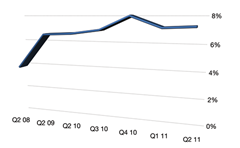Unemployment update
Over 60,000 people are currently unemployed, as the region’s economic recovery staggers.
Northern Ireland has seen a slight rise in unemployment in the second quarter (April-June) of 2011, with the Labour Force Survey showing a 0.1 per cent increase, bringing the rate to 7.3 per cent. There has also been an increase in the number of people claiming unemployment benefits: the July claimant count revealing an extra 600 people claiming the dole, to a total of 60,400.
The 7.3 per cent unemployment rate, published by DETI in August, represents a 0.6 per cent increase over 12 months. The claimant rate, however, whilst showing an increase of 0.1 per cent over the first quarter, is down 0.1 per cent over the past year, signifying negligible change in the number claiming unemployment benefits over the past 12 months.
Figures for the second quarter also reveal there are 538,000 people economically inactive people in Northern Ireland. This is a 17,000 decrease on the first quarter (down 1.2 per cent), and a drop of 21,000 over the year. The rate (among those aged 16-64) stands at 26.6 per cent. Thirty per cent of those ‘inactive’ are so due to sickness or disability, being a student, looking after family or a home, retirement or other reasons. 48.1 per cent of unemployed people here have been unemployed for one year or more. Data show that among 18-24 year olds, 17 per cent are unemployed.
 When looked at in comparison with other regions of the UK, these figures suggest a slower level of economic decline in Northern Ireland. The claimant increase in the UK during Q2 was 2.4 per cent, with Northern Ireland experiencing the smallest increase of the 12 UK regions. The UK’s overall unemployment rate is 7.9 per cent. The Republic’s rate stands at almost double that of the province: 14 per cent.
When looked at in comparison with other regions of the UK, these figures suggest a slower level of economic decline in Northern Ireland. The claimant increase in the UK during Q2 was 2.4 per cent, with Northern Ireland experiencing the smallest increase of the 12 UK regions. The UK’s overall unemployment rate is 7.9 per cent. The Republic’s rate stands at almost double that of the province: 14 per cent.
There was mixed news on the redundancies front. While 195 were confirmed in July (176 in July 2010), this marked a decline of 35 on the previous month, and the overall number in the past year was significantly lower than the previous year: 1,957 compared with 3,034.
Statistics at council level show Derry (8 per cent), Belfast (7.1 per cent) and Limavady (7.1 per cent) with the highest claimant rates. Ards, Newry and Mourne, and Derry saw the highest increases over the past twelve months.
Meanwhile, the Quarterly Employment Survey revealed seasonally adjusted decreases of jobs in manufacturing (160 fewer jobs), and construction (60 fewer jobs) while the services sector saw 870 new jobs in the second quarter.
Commenting on the figures, Enterprise Minister Arlene Foster said: “Our long- term goal has always been to develop a strong and vibrant private sector that can compete internationally and which can provide employment opportunities for the people of Northern Ireland.” She said that “this aim remains unchanged throughout the global economic downturn.”






